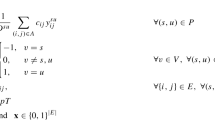Abstract
A lot of minimization covering problems on graphs consist in covering vertices or edges by subgraphs verifying a certain property. These problems can be seen as particular cases of set-covering. If the number of subgraphs is polynomial in the order n of the input-graph, then these problems can be approximated within logarithmic ratio by the classical greedy set-covering algorithm. We extend the class of problems approximable by this approach to covering problems where the number of candidate subgraphs is exponential in n, by revisiting an old technique called “master-slave” and extending it to weighted master or/and slave problems. Finally, we use the master-slave tool to prove some positive approximation results for two network-design and a VLSI-design graph-problems.
Similar content being viewed by others
References
L. Alfandari, “Approximation de problèmes de couverture et de partitionnement de graphes,” PhD Thesis, LAMSADE, Université Paris-Dauphine.
L. Alfandari and V. Th. Paschos, “Approximating the minimum-weight rooted spanning tree with depth two,” ITOR 6, 1999, pp. 607–622.
B.B. Boppana and M.M. Halldórsson, “Approximating maximum independent sets by excluding subgraphs,” BIT, vol. 32, no. 2, pp. 180–196, 1992.
V. Chvátal, “A greedy-heuristic for the set covering problem,” Math. of Oper. Res., vol. 4, pp. 233–235, 1979.
P. Crescenzi and A. Panconesi, “Completeness in approximation classes,” in Lecture Notes in Computer Science, vol. 380: Proc. of Fundamentals of Computation Theory, Springer Verlag, 1989, pp. 116-126.
M.R. Garey and D.S. Johnson, “Computers and Intractability. A Guide to the Theory of NP-Completeness,” W.H. Freeman: San Francisco, 1979.
D.S. Johnson, “Approximation algorithms for combinatorial problems,” J. Comput. System Sci., vol. 9, pp. 256–278, 1974.
D.S. Johnson, “Worst-case behavior of graph-coloring algorithms,” in Proc. South-Eastern Conference on Combinatorics, Graph Theory and Computing, 1974, p. 513-528.
J.B. Kruskal, “On the shortest spanning subtree of a graph and the traveling salesman problem,” Proc. Amer. Math. Soc., vol. 7, no. 1, pp. 48–50, 1956.
M. Minoux, “Some combinatorial optimization problems from VLSI-design,” in Research Seminar “Optimization”, Université Paris I, 1991.
A. Panconesi and D. Ranjan, “Quantifiers and approximation,” in Proc. STOC'90, 1990, pp. 446-456.
H.U. Simon, “On approximate solutions for combinatorial optimization problems,” SIAM J. Disc. Math., vol. 3, no. 2, pp. 294–310, 1990.
P. Slavík, “A tight analysis of the greedy algorithm for set cover,” in Proc. STOC'96, 1996, pp. 435-441.
Author information
Authors and Affiliations
Rights and permissions
About this article
Cite this article
Alfandari, L., Paschos, V.T. Master-Slave Strategy and Polynomial Approximation. Computational Optimization and Applications 16, 231–245 (2000). https://doi.org/10.1023/A:1008764212265
Issue Date:
DOI: https://doi.org/10.1023/A:1008764212265




